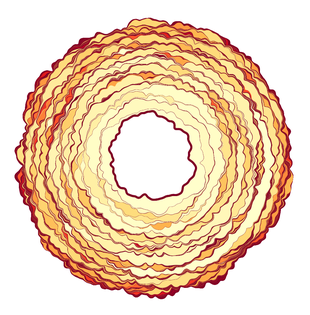While sticky notes and adhesive tape are easy to apply to a surface, they are challenging to take off. Adhesion hysteresis is a phenomenon that is mostly seen in soft, elastic materials: adhesive contact forms easier than it breaks. Researchers at the University of Freiburg, University of Pittsburgh, and University of Akron in the US have found that the adhering soft materials’ surface roughness is what causes this adhesion hysteresis.
 The simulation shows the contact area of a soft solid that is separated from a rough surface. Each colored spot corresponds to an instability of the contact. The different color intensity shows how much energy is lost in the process. Image Credit: Antoine Sanner, Lars Pastewka
The simulation shows the contact area of a soft solid that is separated from a rough surface. Each colored spot corresponds to an instability of the contact. The different color intensity shows how much energy is lost in the process. Image Credit: Antoine Sanner, Lars Pastewka
The scientists showed that roughness impedes the separation process by causing the materials to separate in tiny, abrupt motions that gradually release portions of the adhesive bond using a combination of experimental observations and simulations.
Dr. Antoine Sanner and Prof. Dr. Lars Pastewka from the Department of Microsystems Engineering and the livMatS Cluster of Excellence at the University of Freiburg, Dr. Nityanshu Kumar and Prof. Dr. Ali Dhinojwala from the University of Akron, and Prof. Dr. Tevis Jacobs from the University of Pittsburgh have published their findings in the prestigious journal Science Advances.
Our findings will make it possible to specifically control the adhesion properties of soft materials through surface roughness. They will also allow new and improved applications to be developed in soft robotics or production technology in the future, for example for grippers or placement systems.
Dr. Antoine Sanner, Department of Microsystems Engineering, University of Freiburg
Sudden Jumping Movement of the Edge of the Contact
Until now, adhesion hysteresis in soft substances has been believed to be caused by viscoelastic energy dissipation. The material deforms during the contact cycle, contracting during contact and expanding during release, which results in the loss of energy due to heat. The adhesive force increases during separation as a result of those energy losses counteracting the movement of the contact surface.
Contact aging, or the development of chemical bonds on the contact surface, has also been proposed as a reason. The longer the contact remains, the stronger the adhesion.
Sanner added, “Our simulations show that the observed hysteresis can be explained without these specific energy dissipation mechanisms. The only source of energy dissipation in our numerical model is the sudden jumping movement of the edge of the contact, which is induced by the roughness.”
Adhesion Hysteresis Calculated for Realistic Surface Roughness
Both the University of Akron’s adhesion experiments and the Freiburg researchers’ simulations exhibit this abrupt jumping action with remarkable clarity.
The abrupt change in the contact surface was already mentioned in the 1990s as a possible cause of adhesion hysteresis, but previous theoretical work on this was limited to simplified surface properties.
Dr. Nityanshu Kumar, University of Akron
Prof. Dr. Tevis Jacobs from the University of Pittsburgh concluded, “We have succeeded for the first time in calculating the adhesion hysteresis for realistic surface roughness. This is based on the efficiency of the numerical model and an extremely detailed surface characterization carried out by researchers at the University of Pittsburgh.”
The study was funded by the German Research Foundation (livMatS - EXC 2193), the European Research Council (StG 757343), the National Science Foundation (DMR-2208464), and the National Institute for Occupational Safety and Health (R21 OH012126) funded the study.
Journal Reference:
Sanner, A., et. al. (2024) Why soft contacts are stickier when breaking than when making them. Science Advances. doi:10.1126/sciadv.adl1277.